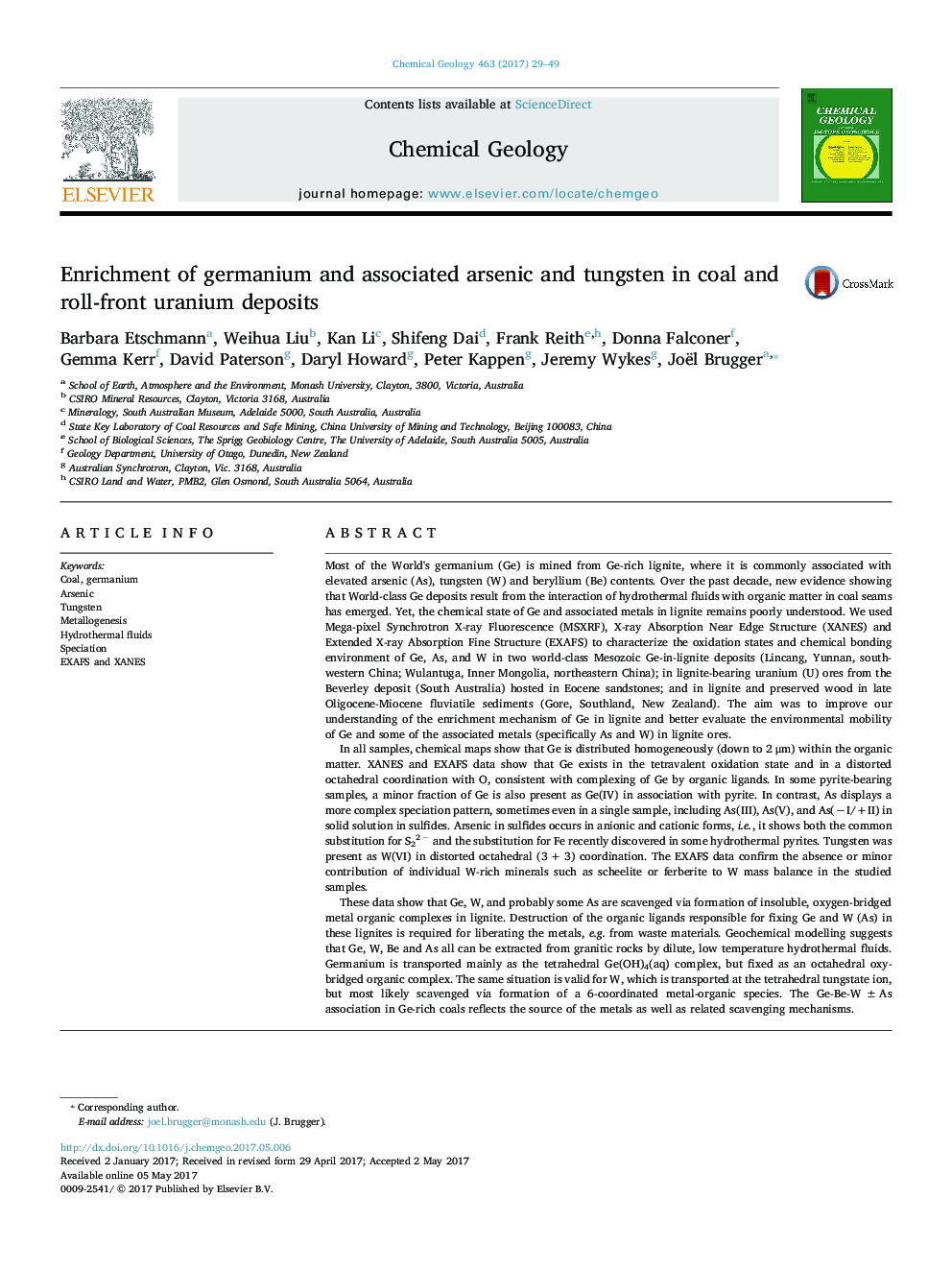| کد مقاله | کد نشریه | سال انتشار | مقاله انگلیسی | نسخه تمام متن |
|---|---|---|---|---|
| 5782613 | 1637511 | 2017 | 21 صفحه PDF | دانلود رایگان |
Most of the World's germanium (Ge) is mined from Ge-rich lignite, where it is commonly associated with elevated arsenic (As), tungsten (W) and beryllium (Be) contents. Over the past decade, new evidence showing that World-class Ge deposits result from the interaction of hydrothermal fluids with organic matter in coal seams has emerged. Yet, the chemical state of Ge and associated metals in lignite remains poorly understood. We used Mega-pixel Synchrotron X-ray Fluorescence (MSXRF), X-ray Absorption Near Edge Structure (XANES) and Extended X-ray Absorption Fine Structure (EXAFS) to characterize the oxidation states and chemical bonding environment of Ge, As, and W in two world-class Mesozoic Ge-in-lignite deposits (Lincang, Yunnan, southwestern China; Wulantuga, Inner Mongolia, northeastern China); in lignite-bearing uranium (U) ores from the Beverley deposit (South Australia) hosted in Eocene sandstones; and in lignite and preserved wood in late Oligocene-Miocene fluviatile sediments (Gore, Southland, New Zealand). The aim was to improve our understanding of the enrichment mechanism of Ge in lignite and better evaluate the environmental mobility of Ge and some of the associated metals (specifically As and W) in lignite ores.In all samples, chemical maps show that Ge is distributed homogeneously (down to 2 μm) within the organic matter. XANES and EXAFS data show that Ge exists in the tetravalent oxidation state and in a distorted octahedral coordination with O, consistent with complexing of Ge by organic ligands. In some pyrite-bearing samples, a minor fraction of Ge is also present as Ge(IV) in association with pyrite. In contrast, As displays a more complex speciation pattern, sometimes even in a single sample, including As(III), As(V), and As(âI/+II) in solid solution in sulfides. Arsenic in sulfides occurs in anionic and cationic forms, i.e., it shows both the common substitution for S22 â and the substitution for Fe recently discovered in some hydrothermal pyrites. Tungsten was present as W(VI) in distorted octahedral (3 + 3) coordination. The EXAFS data confirm the absence or minor contribution of individual W-rich minerals such as scheelite or ferberite to W mass balance in the studied samples.These data show that Ge, W, and probably some As are scavenged via formation of insoluble, oxygen-bridged metal organic complexes in lignite. Destruction of the organic ligands responsible for fixing Ge and W (As) in these lignites is required for liberating the metals, e.g. from waste materials. Geochemical modelling suggests that Ge, W, Be and As all can be extracted from granitic rocks by dilute, low temperature hydrothermal fluids. Germanium is transported mainly as the tetrahedral Ge(OH)4(aq) complex, but fixed as an octahedral oxy-bridged organic complex. The same situation is valid for W, which is transported at the tetrahedral tungstate ion, but most likely scavenged via formation of a 6-coordinated metal-organic species. The Ge-Be-W ±As association in Ge-rich coals reflects the source of the metals as well as related scavenging mechanisms.
Journal: Chemical Geology - Volume 463, 5 July 2017, Pages 29-49
